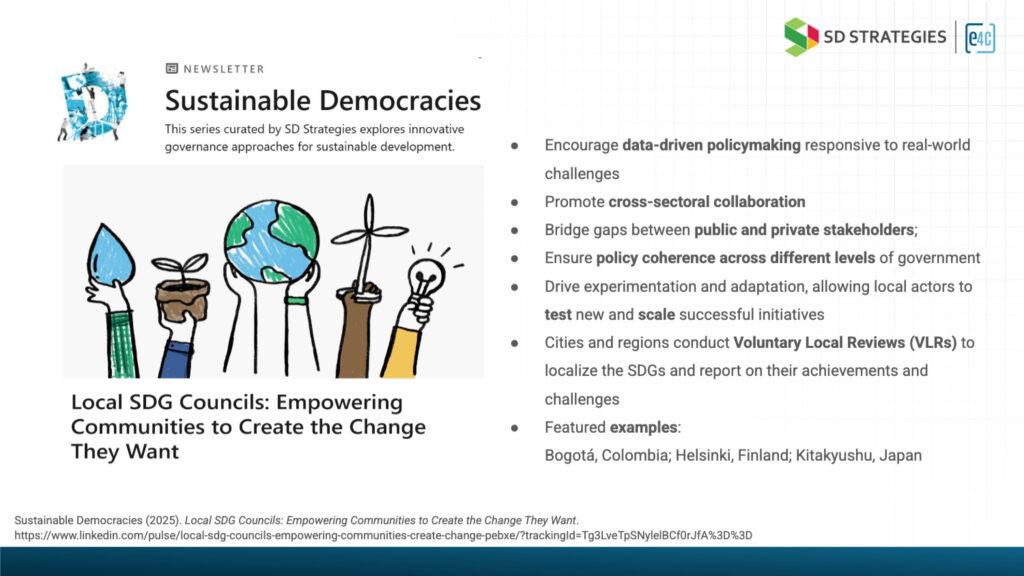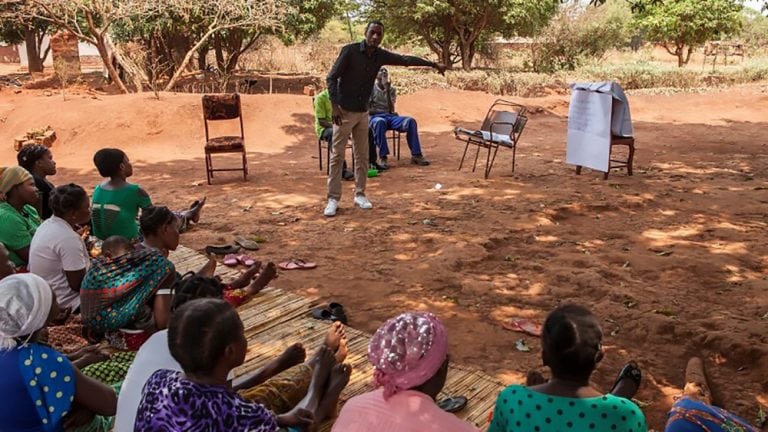If the world is going to meet the Sustainable Development Goals, much of the work will take place in city halls, community centers, and engineering labs. That’s the message Alexander Ochs, founder of Berlin-based SD Strategies, gave to Engineering for Change Fellows, describing local action as the key to meeting global climate goals.
Read More: Alexander Ochs’ slides: From Global Goals to Local Action: Understanding the SDGs (pdf)
The Need for Engineers and “Real People”
Policy makers and the consultants and others in their constellations depend on “real people,” Mr. Ochs says, for implementation. Building renewable energy grids, redesigning transport systems, retrofitting buildings and everything that nudges us measurably closer to the goals depends on local expertise and actual implementation.
“So, we’re setting the framework. But to really put this into action, we need engineers and we need practitioners to make the change happen,” Mr. Ochs says. “Without you, we are nothing.”
SD Strategies, Mr. Ochs’ organization, translates global climate and sustainable development goals into policy roadmaps and implementation plans at the national and subnational levels. The organization works to turn high-level pledges into concrete projects. “It is a principle for us to work with local policy makers, local organizations or, at a minimum, local consultants” says Mr. Ochs, “because they best understand what’s needed in their particular environments.”
The SDGs: A Report Card
The United Nations Sustainable Development Goals (SDGs), adopted in 2015, are the world’s shared to-do list for ending poverty, fighting climate change, and building a fairer economy.
How are we doing? Mr. Ochs offered a mixed review.
The good news is that energy access (SDG 7) has improved, with more than 300 million people gaining electricity since 2015 who did not have it before. The bad news is that only 18 percent of all SDG targets are on track. Climate action, gender equality, and biodiversity protection in particular are lagging.
The goals are deeply interconnected, Mr. Ochs says.
“To understand them better and to measure them, it makes a lot of sense to break them up in in 17 goals and 169 targets. But in reality, they often overlap, and the crux of the matter is, really, how can we find strategies to make them all happen, building one on the other, using synergies wherever possible.”
As an example, a solar power project will help with clean energy (SDG 7) but it may fail to create sustained, inclusive and sustainable economic growth (SDG 8) or to consider gender equity (SDG 5) to the extent it could. Localization can help make better decisions with amplified impact.
Introducing Local SDG Councils

Image: Alexander Ochs
Local SDG Councils are grassroots assemblies that bring together mayors and local policymakers, businesses, experts, and citizens to design concrete actions in their communities.
Mr. Ochs highlighted three standout examples.
Bogotá, Colombia, has had a traffic problem, but the city now runs one of Latin America’s largest electric bus fleets. Their SDG Council focused on clean transport, safety for women, and poverty reduction, addressing three SDGs with one solution.
Helsinki, Finland, embeds the achievement of the SDGs into thematic working groups. The groups engage citizens and promote cross-sectoral collaboration.
Kitakyushu has reinvented itself from one of the most polluted industrial cities in Japan to a green manufacturing hub and model of sustainable development. The city’s workers, companies, and policymakers have all been closely involved in the transformation.
How communities share their experiences
The changes implemented in those three cities were advised by local SDG councils. One of the important jobs such councils can perform is experimentation.
“We can learn as much from their failures as from their successes,” Mr. Ochs says. Cities can test policies on a small scale before rolling them out nationally. If they fail, the stakes are relatively low. If they work, they can be scaled up and replicated.
Cities and their local SDG Councils can share their experiences through international networks, exchange programs, conferences and platforms like the UN’s voluntary local review process.
The Bigger Picture: Restored Trust and Sustainable Democracies
Local councils working toward climate goals and the other SDGs can rebuild trust in democratic institutions, Mr. Ochs says.
One example is in Georgia. Civil society organizations (CSOs), NGOs, and local municipalities are actively involved in the nation’s SDG Council to ensure that the Council’s work is not limited to government agencies but includes input from a broad range of stakeholders. . The policy gives ordinary citizens a chance to participate in planning sustainable development.
Globally, SDG councils help create transparency in public policymaking, often giving more of a voice to women, youth, and marginalized people, aiming to leave no one in the community behind, Mr. Ochs says.
What’s Next
To support that work, Mr. Ochs and SD Strategies created two new initiatives: The newsletter Sustainable Democracies explores new innovative tools, policies and approaches aiming to make our societies, economies, and political systems more sustainable, The Forum for Atlantic Climate and Energy Talks (FACET) is a new, collaborative platform to advance transatlantic dialogue on climate change, and sustainable development at a time when many official ties are cut..
“We want to create new spaces where we can show that our democratic, liberal systems, based on the rule of law, have been able to produce a lot of progress in the interest of All. Nobody who looks at it more closely, will want to turn the clock back. But, and this is the other side of the coin, our systems need to constantly change and adjust to new challenges. We can and must learn from our successes and failures. There is an enormous need for reform and innovative new solutions to both our democratic processes and our sustainability transformations. Democratic and sustainable development go hand in hand,” Mr. Ochs says.
At their best, platforms such as Sustainable Democracies and FACET may lead to larger scale solutions. And scale is the takeaway, from local to global methods of meeting the SDGs. Bogotá, Kitakyushu, and many other cities and municipalities around the world demonstrate that blueprints for meeting the SDGs already exist. Now it’s about scaling up and innovating.

